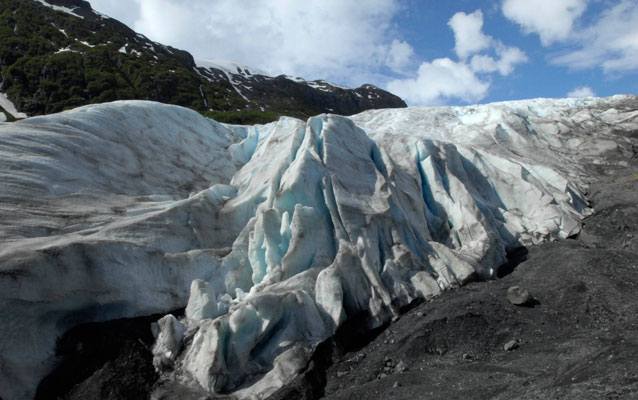Last updated: November 24, 2021
Lesson Plan
Glacial Detectives

- Grade Level:
- Upper Elementary: Third Grade through Fifth Grade
- Subject:
- Science
- Lesson Duration:
- 90 Minutes
- Additional Standards:
- NATIONAL STANDARDS: Science D 1, F 4, G 1
- Thinking Skills:
- Remembering: Recalling or recognizing information ideas, and principles. Understanding: Understand the main idea of material heard, viewed, or read. Interpret or summarize the ideas in own words. Applying: Apply an abstract idea in a concrete situation to solve a problem or relate it to a prior experience. Analyzing: Break down a concept or idea into parts and show the relationships among the parts.
Essential Question
What are glaciers? How do they form? How do they move?
Objective
Students will learn about glacial features by examining real photographs from Kenai Fjords National Park. In small groups, students will study photos and learn how glaciers move, how they affect the lands around them, and what clues they leave when they have been in an area.
Background
Teachers need to read the Glaciers (pg 69) and Harding Icefield (pg 73) sections of the Forging Connectionsresource.
Together as a class, read chapters 3, 4 and 5 of Frozen in Motion.
Preparation
All of the readings and worksheet can be found in the resource: Forging Connections - An Educational Resource For Kenai Fjords National Park.
- Lesson plan is found on page 87.
- "Glaciers" reading is found on page 69.
- "Harding Icefield" reading is found on page 73.
- Worksheet is found on page 92.
Materials
Teacher Resource Guide
Download Teacher Resource Guide
Procedure
Set up seven stations and place pictures from each of the above groups at each station. Divide the class into 7 “Investigative Teams.” Tell them they will be working as a group to unravel clues about glaciers. Give each team a Glacial Detective Worksheet (pg 92) and let them know they will have about 5 minutes at each station. Their job is to look at the pictures and try to answer the questions for each station in as much detail as they can. Keep time and let groups know when they should move on to the next station.
Vocabulary
Braided Stream, Calving, Cirque, Glacier, Crevasse, Fjord, Glacial Advance, Glacial Recession, Glacier, Iceberg, Icefield, Moraine, Morphology, Outwash Plain, Serac, Striation, Tidewater, Glacier, Valley Glacier.
Assessment Materials
At the end of 30 minutes gather the groups together and discuss each of the stations. Students should be able to grasp these concepts in the group discussion:
- How are glaciers formed
- Do glaciers move? If so, what causes them to move?
- What are some signs of movement you may have seen in the photographs?
- Do glaciers affect the land around them? In what ways?
- Does the land or do people affect glaciers? In what ways?
- Are there different kinds of glaciers? Can you say what makes them different?
- Why do we have a national park with glaciers in it?
- Do you think there are any history lessons in Kenai Fjords National Park?
Enrichment Activities
For older groups, spend some time talking about the Harding Ice field. What is an icefi eld? How does it form? When did this one form? What conditions make Seward a place where icefields and glaciers can exist? Plan a field trip to Kenai Fjords National Park, or perhaps a distance learning visit?
Additional Resources
To help students understand the concept of national parks spend some discussion time on station 7 and the bonus question. The four reasons we have national parks are:
- Conservation—Parks help preserve the animals and the ecosystem that supports them.
- Education—So that anyone can visit parks and learn more about the geology, biology, and cultural history that are a part of the park.
- Enjoyment—So people can come and just appreciate the beauty and wonders.
- Inspiration—Hopefully, once you’ve seen a national park you’ll leave feeling different, perhaps wanting to draw or paint or write. Inspiration is the feeling that drives many artists to create.
Alaska’s Glaciers: Frozen in Motion by Katherine Hocker, Alaska Geographic, Anchorage, 2005.
